Baikal Region (Russia) Development Prospects Based on the Green Economy Principles
Abstract
1. Introduction
2. Materials and Methods
2.1. Study Area
2.2. Statistical Method
2.3. Neural Network Method
3. Results
4. Discussion
- Introduce more functional treatment facilities, waste sorting stations, water-saving systems, and improve water use’s economic mechanism. Reconstruction and modernization of industrial production, work on the creation and use of environmentally friendly technologies. To make higher demands on the location and functioning of the productive forces in the region;
- Develop a feasibility study for the creation of environmentally friendly production in the mining industry and the fuel and energy sector;
- Create and modernize transport and energy infrastructure that can create new green jobs [62];
- Exercise control over the observance of existing laws on environmental protection and ensure the environmental safety of the population and the preservation of natural systems. to study the negative impact of emissions and discharges of harmful (polluting) substances on the natural territory of Lake Baikal and develop scientifically based recommendations for their regulation; full coverage of the state environmental monitoring of the Baikal natural territory;
- Develop ecological tourism, which is more suitable for Baikal’s status as a world natural monument. Such tourism, firstly, does not violate the integrity of the ecosystem, and secondly, it is beneficial to the local population. Ecological tourism is inherently expensive tourism, and it cannot be massive. The very massive nature of the tourist flow negates the possibility of full-fledged communication between man and nature, which should be the meaning of rest on Lake Baikal [63]
5. Conclusions
Author Contributions
Funding
Institutional Review Board Statement
Informed Consent Statement
Data Availability Statement
Acknowledgments
Conflicts of Interest
Appendix A
| No. | Indicator | Actual 2018 | Forecast | |||||||||||
|---|---|---|---|---|---|---|---|---|---|---|---|---|---|---|
| Estimate 2019 | 2020 | 2021 | 2022 | 2023 | 2024 | 2025 | 2026 | 2027 | 2028 | 2029 | 2030 | |||
| 1. Eco-capacity of air, kg per capita | ||||||||||||||
| 1.1 | Republic of Buryatia | 114.8 | 103.266 | 105.773 | 107.279 | 99.981 | 99.782 | 98.121 | 94.304 | 88.943 | 84.588 | 82.601 | 80.344 | 79.29 |
| 1.2 | Irkutsk oblast | 275 | 273.001 | 268.539 | 252.598 | 250.283 | 248.225 | 242.606 | 235.311 | 225.313 | 216.675 | 210.944 | 195.986 | 179.825 |
| 1.3 | Zabaykalsky krai | 125 | 114.85 | 110.849 | 112.693 | 115.668 | 114.694 | 112.067 | 110.833 | 100.299 | 98.951 | 95.771 | 93.5 | 90.339 |
| 2. Eco-capacity of wastewater, m3 per capita | ||||||||||||||
| 2.1 | Republic of Buryatia | 35.55 | 34.303 | 32.214 | 33.419 | 34.406 | 34.402 | 33.022 | 30.77 | 31.525 | 32.516 | 30.028 | 29.285 | 23.106 |
| 2.2 | Irkutsk oblast | 343 | 320.196 | 286.403 | 275.095 | 276.641 | 264.926 | 256.71 | 251.545 | 252.476 | 249.293 | 250.665 | 251.951 | 248.533 |
| 2.3 | Zabaykalsky krai | 199 | 185.247 | 172.138 | 168.198 | 160.243 | 158.869 | 151.164 | 154.851 | 153.269 | 151.346 | 152.648 | 150.997 | 147.584 |
| 3. Eco-capacity of waste, kg per capita | ||||||||||||||
| 3.1 | Republic of Buryatia | 49.168 | 56.025 | 58.628 | 56.238 | 52.489 | 47.793 | 42.93 | 34.706 | 38.869 | 38.749 | 37.826 | 26.994 | 25.567 |
| 3.2 | Irkutsk oblast | 56.577 | 58.346 | 58.322 | 58.434 | 56.855 | 52.986 | 50.792 | 47.84 | 43.541 | 43.365 | 40.248 | 30.699 | 23.87 |
| 3.3 | Zabaykalsky krai | 179.042 | 184.607 | 185.221 | 177.447 | 170.931 | 165.273 | 164.618 | 160.631 | 156.785 | 150.971 | 143.048 | 141.47 | 130.895 |
| No. | Indicator | Actual 2018 | Forecast | |||||||||||
|---|---|---|---|---|---|---|---|---|---|---|---|---|---|---|
| Estimate 2019 | 2020 | 2021 | 2022 | 2023 | 2024 | 2025 | 2026 | 2027 | 2028 | 2029 | 2030 | |||
| 1. Eco-intensity of air, kg/USD | ||||||||||||||
| 1.1 | Republic of Buryatia | 0.0019 | 0.00181 | 0.00174 | 0.00173 | 0.0017 | 0.00168 | 0.00163 | 0.00166 | 0.00164 | 0.00161 | 0.00159 | 0.00153 | 0.00152 |
| 1.2 | Irkutsk oblast | 0.0323 | 0.0328 | 0.0323 | 0.0321 | 0.0318 | 0.0301 | 0.0295 | 0.0294 | 0.0287 | 0.0282 | 0.02801 | 0.028 | 0.027 |
| 1.3 | Zabaykalsky krai | 0.026 | 0.0278 | 0.0277 | 0.02716 | 0.02723 | 0.02714 | 0.02704 | 0.0267 | 0.0262 | 0.0257 | 0.0245 | 0.0239 | 0.0225 |
| 2. Eco-intensity of wastewater, tons/USD | ||||||||||||||
| 2.1 | Republic of Buryatia | 0.0101 | 0.008 | 0.0069 | 0.006 | 0.0049 | 0.004219 | 0.00401 | 0.00361 | 0.003129 | 0.00281 | 0.00211 | 0.002075 | 0.00192 |
| 2.2 | Irkutsk oblast | 0.0403 | 0.0399 | 0.0374 | 0.0355 | 0.0334 | 0.0308 | 0.0266 | 0.0239 | 0.0217 | 0.0198 | 0.01589 | 0.0136 | 0.0121 |
| 2.3 | Zabaykalsky krai | 0.0413 | 0.0412 | 0.0411 | 0.0399 | 0.0392 | 0.0389 | 0.0381 | 0.0372 | 0.0347 | 0.0326 | 0.0291 | 0.0257 | 0.0243 |
| 3. Eco-intensity of waste, kg/USD | ||||||||||||||
| 3.1 | Republic of Buryatia | 0.8299 | 0.5545 | 0.4962 | 0.4582 | 0.3929 | 0.3235 | 0.3069 | 0.272 | 0.2701 | 0.2298 | 0.2339 | 0.2232 | 0.2027 |
| 3.2 | Irkutsk oblast | 6.6506 | 8.032 | 7.903 | 7.127 | 7.03 | 7.026 | 6.513 | 6.317 | 6.255 | 5.925 | 5.864 | 4.765 | 3.99 |
| 3.3 | Zabaykalsky krai | 37.246 | 36.982 | 35.843 | 34.177 | 34.023 | 33.73 | 32.303 | 29.735 | 27.056 | 26.833 | 25.456 | 25.124 | 24.2099 |
References
- Cheng, H.; Dong, S.; Li, F.; Yang, Y.; Li, Y.; Li, Z. A circular economy system for breaking the development dilemma of ‘ecological Fragility-Economic poverty’ vicious circle: A CEEPS-SD analysis. J. Clean. Prod. 2019, 212, 381–392. [Google Scholar] [CrossRef]
- Davies, A.R.; Mullin, S.J. Greening the economy: Interrogating sustainability innovations beyond the mainstream. J. Econ. Geogr. 2011, 11, 793–816. [Google Scholar] [CrossRef]
- A Guidebook to the Green Economy Issue 2: Exploring Green Economy Principles. Available online: https://sustainabledevelopment.un.org/content/documents/743GE%20Guidebook%202%20-%20Principles_final.pdf (accessed on 10 October 2020).
- Barbier, E.B.; Markandya, A. A New Blueprint for A Green Economy, 1st ed.; Routledge: London, UK, 2013; 216p. [Google Scholar] [CrossRef]
- Pearce, D.; Markandya, A.; Barbier, E. Blueprint for A Green Economy; Earthscan: London, UK, 1989. [Google Scholar]
- Bina, O.; La Camera, F. Promise and shortcomings of a green turn in recent policy responses to the ‘double crisis’. Ecol. Econ. 2011, 70, 2308–2316. [Google Scholar] [CrossRef]
- Georgeson, L.; Maslin, M.; Poessinouw, M. The global green economy: A review of concepts, definitions, measurement methodologies and their interactions. Geo Geogr. Environ. 2017, 4, e00036. [Google Scholar] [CrossRef]
- D’Amato, D.; Droste, N.; Allen, B.; Kettunen, M.; Lähtinen, K.; Korhonen, J.; Toppinen, A. Green, circular, bio economy: A comparative analysis of sustainability avenues. J. Clean. Prod. 2017, 168, 716–734. [Google Scholar] [CrossRef]
- Nahman, A.; Mahumani, B.; De Lange, W. Beyond GDP: Towards a Green Economy Index. Dev. S. Afr. 2016. [Google Scholar] [CrossRef]
- Barbier, E.B. The green economy post Rio+20. Science 2012, 338, 887–888. [Google Scholar] [CrossRef]
- UN. The Future We Want. The Outcome Document of the UN Conference on Sustainable Development; United Nations: New York, NY, USA, 2012; 66p. [Google Scholar]
- United Nations. The 2030 Agenda for Sustainable Development. Available online: http://www.un.org/ga/search/view_doc.asp?symbol=A/RES/70/1&Lang=E (accessed on 9 June 2020).
- The Adoption of the Paris Agreement. In Proceedings of the Conference of the Parties on its Twenty-fist Session, Paris, France, 30 November–11 December 2015. The Framework Convention of the United Nations Framework Convention on Climate Change; UN: New York, NY, USA, 2015; 42р. (In Russian). Available online: www.unfccc.int/resource/docs/2015/cop21/rus/l09r.pdf (accessed on 13 December 2020).
- Gibbs, D.; O’Neill, K. Green Entrepreneurship: Building a Green Economy?—Evidence from the UK. In Social and Sustainable Enterprise: Changing the Nature of Business (Contemporary Issues in Entrepreneurship Research); Underwood, S., Blundel, R., Lyon, F., Schaefer, A., Eds.; Emerald Group Publishing Limited: Bingley, UK, 2012; Volume 3, pp. 75–96. [Google Scholar] [CrossRef]
- Mcafee, K. Green economy and carbon markets for conservation and development: A critical view. Int. Environ. Agreem. 2015. [Google Scholar] [CrossRef]
- Bell, K. ‘Living Well’ as a Path to Social, Ecological and Economic Sustainability. Urban. Plan. 2017, 2, 19–33. [Google Scholar] [CrossRef]
- Barbier, E. Building the Green Economy. Can. Public Policy 2016, 42, S1–S9. [Google Scholar] [CrossRef]
- United Nations Department of Economic and Social Affairs. Policy Integration in Government in Pursuit of the Sustainable Development Goals; United Nations Department of Economic and Social Affairs: New York, NY, USA, 2015. [Google Scholar]
- Pahle, M.; Pachauri, S.; Steinbacher, K. Can the Green Economy deliver it all? Experiences of renewable energy policies with socio-economic objectives. Appl. Energy 2016, 179. [Google Scholar] [CrossRef]
- Lyubimova, E.V. First steps of solar energy in Siberia. Interexpo Geo-Sib. 2018, 1, 198–205. [Google Scholar]
- Lambert, R.J.; Silva, P.P. The challenges of determining the employment effects of renewable energy. Renew. Sustain. Energy Rev. 2012, 16, 4667–4674. [Google Scholar] [CrossRef]
- Barbier, E. Is green growth relevant for poor economies? Resour. Energy Econ. 2016, 45, 178–191. [Google Scholar] [CrossRef]
- Gomboev, B.; Badmaev, A. “Green economy” as one of the grounds for reaching the goals of sustainable development. Bull. Buryat Sci. Cent. Sb Ras 2017, 2, 109–116. [Google Scholar]
- Yantranov, A.; Sangadieva, I. Potential of the transition of the Baikal region’s economy to sustainable development based on the principles of a “green” economy. Econ. Syst. Manag. 2017, 3, 25. [Google Scholar]
- Zomonova, E. Definition and principles of green economy. Azimuth Sci. Res. Econ. Adm. 2016, 5, 13–17. [Google Scholar]
- Bilgaev, A.; Dong, S.; Li, F.; Hao, C.; Sadykova, E.; Mikheeva, A. Assessment of the Current Eco-Socio-Economic Situation of the Baikal Region (Russia) from the Perspective of the Green Economy Development. Sustainability 2020, 12, 3767. [Google Scholar] [CrossRef]
- Bilgaeva, L.; Sadykova, E.; Ochirova, G.; Zhigdorzhiev, V. Neuroevolutionary forecasting of innovative development of the region with ecological aspect. In Proceedings of the International Workshop AMSA’2017, Krasnoyarsk, Russia, 18–22 September 2017; NSTU: Novosibirsk, Russia, 2017; pp. 49–57. [Google Scholar]
- Bilgaeva, L.; Sadykova, E.; Filippov, V. Automatic Generation of Neural Network Topology to Forecast the International Integration Processes. In Proceedings of the International Multi-Conference on Industrial Engineering and Modern Technologies, Vladivostok, Russian, 6–9 October 2020; FarEastCon: Vladivostok, Russian, 2019. [Google Scholar] [CrossRef]
- Toolokhonov, A.K. How to Develop the Russian Periphery or Some Lessons from China’s Reforms. ECO 2008, 7, 2–15. [Google Scholar]
- Bilgaeva, L.P.; Sadykova, E.T.S.; Filippov, V.A. Automatic Construction of Neural Network Topology Using Activation Function Mutation to Solve the Forecasting Problem. No. 2019663738, 22 November 2019. [Google Scholar]
- Strategy of Socio-Economic Development of the Republic of Buryatia. Available online: https://egov-buryatia.ru/minec/activities/directions/strategicheskoe-upravlenie/strategicheskoe-planirovanie/strategiya-ser-rb (accessed on 13 November 2020).
- On Approval of the Progress Report on the Implementation of the Action Plan for the Zabaykalsky Krai Socio-Economic Development Strategy Implementation for the Period up to 2030. Available online: https://75.ru/o-krae/ekonomika/strategii (accessed on 13 November 2020).
- Draft Strategy for the Socio-Economic Development of Irkutsk Oblast until 2036. Available online: https://irkobl.ru/sites/economy/socio-economic/project2036/ (accessed on 13 November 2020).
- Box, G.E.; Jenkins, G.M.; Reinsel, G.C.; Ljuing, G.M. Time Series Analysis: Forecasting and Control, 5th ed.; Wiley: Hoboken NJ, USA, 2016. [Google Scholar]
- Guerard, J.B. Regression Analysis and Forecasting Models. In Introduction to Financial Forecasting in Investment Analysis; Springer: New York, NY, USA, 2013; pp. 19–45. [Google Scholar]
- Gladkov, L.A.; Kureychik, V.V.; Kureychik, V.M. Genetic Algorithms; Fizmatlit: Moscow, Russia, 2006; 320p. [Google Scholar]
- Aggarval, C.C. Data Mining; Springer: Cham, Switzerland, 2015. [Google Scholar]
- Osovsky, S. Neural Networks for Information Processing; Hot Line-Telecom: Moscow, Russia, 2016; 448p. [Google Scholar]
- Rosenblatt, F. Principles of Neurodynamics: Perceptrons and the Theory of Brain Mechanisms; Spartan Books: Washington, DC, USA, 1962; 616p. [Google Scholar]
- Eiben, A.E.; Smith, J.E. Introduction to Evolutionary Computing, 2nd ed.; Springer: Heidelberg/Berlin, Germany, 2015. [Google Scholar]
- Cook, T.R.; Hall, A.S. Macroeconomic Indicator Forecasting with Deep Neural Networks. In Proceedings of the CARMA 2018—2nd International Conference on Advanced Research Methods and Analytics, Valencia, Spain, 12–13 July 2018. [Google Scholar] [CrossRef]
- Haykin, S. Neural Networks, A Comprehensive Foundation; Macmillan College Publishing Company: New York, NY, USA, 1994. [Google Scholar]
- Osowski, S. Sieci Neuronowe w Ujecin Algorytmicznum; WNT: Warsaw, Poland, 1996. [Google Scholar]
- Stanley, K.O.; Miikkulainen, R. Evolving Neural Networks Through Augmenting Topologies. Evol. Comput. 2002, 10, 109–127. [Google Scholar] [CrossRef]
- Gorban, A.N. Training of Neural Networks; ParaGraph: Moscow, Russia, 1990; 160p. [Google Scholar]
- Munshi, A.; Gaster, B.; Mattson, T.G.; Fung, J.; Ginsburg, D. OpenCL Programming Guide; Addison-Wesley Professional: Boston, MA, USA, 2011; 648p. [Google Scholar]
- Rosstat. Regions of Russia. Socio-Economic Indicators; Rosstat: Moscow, Russia, 2018; p. 1162. [Google Scholar]
- Federal State Statistic Service Republic of Buryatia Branch. Available online: https://burstat.gks.ru/publication_bur (accessed on 19 June 2020).
- Federal State Statistic Service Irkutsk Oblast Branch. Available online: https://irkutskstat.gks.ru/folder/35281 (accessed on 19 June 2020).
- Federal State Statistic Service Zabaykalsky Krai Branch. Available online: https://chita.gks.ru/publication_collection (accessed on 19 June 2020).
- State Program of the Russian Federation “Social Support of Citizens”. Available online: https://mintrud.gov.ru/ministry/programms/3/2/ (accessed on 9 November 2020).
- State Program of the Russian Federation “Socio-Economic Development of the Far Eastern Federal District”. Available online: https://minvr.gov.ru/activity/gosprogrammy/sotsialno-ekonomicheskoe-razvitie-dalnevostochnogo/ (accessed on 9 November 2020).
- The Strategy of Socio-Economic Development of the Russian Federation until 2035. Available online: https://www.economy.gov.ru (accessed on 10 November 2020).
- Lin, M.-X.; Liou, H.M.; Chou, K.T. National Energy Transition Framework toward SDG7 with Legal Reforms and Policy Bundles: The Case of Taiwan and Its Comparison with Japan. Energies 2020, 13, 1387. [Google Scholar] [CrossRef]
- The Strategies for the Spatial Development of the Russian Federation for the Period up to 2025. Available online: http://static.government.ru/media/files/UVAlqUtT08o60RktoOXl22JjAe7irNxc.pdf (accessed on 10 November 2020).
- O’Neill, K.; Gibbs, D. Rethinking green entrepreneurship—Fluid narratives of the green economy. Environ. Plan. A 2016, 48. [Google Scholar] [CrossRef]
- Tsoutsos, T.; Frantzeskaki, N.; Gekas, V. Environmental impacts from the solar energy technologies. Energy Policy 2005, 33, 289–296. [Google Scholar] [CrossRef]
- Turney, D.; Fthenakis, V. Environmental impacts from the installation and operation of large-scale solar power plants. Renew. Sustain. Eneregy Rev. 2011, 15, 3261–3270. [Google Scholar] [CrossRef]
- Gasparatos, A.; Doll, C.; Esteban, M.; Ahmed, A.; Olang, T. Renewable energy and biodiversity: Implications for transitioning to a Green Economy. Renew. Sust. Energ. Rev. 2017, 70, 161–184. [Google Scholar] [CrossRef]
- Molina-Moreno, V.; Núñez-Cacho Utrilla, P.; Cortés-García, F.J.; Peña-García, A. The Use of Led Technology and Biomass to Power Public Lighting in a Local Context: The Case of Baeza (Spain). Energies 2018, 11, 1783. [Google Scholar] [CrossRef]
- Han, X.; Zhang, M.; Liu, S. Research on the relationship of economic growth and environmental pollution in Shandong province based on environmental Kuznets curve. Energy Procedia 2011, 5, 508–512. [Google Scholar] [CrossRef]
- Scotini, R.; Skinner, I.; Racioppi, F.; Fusé, V.; Bertucci, J.D.O.; Tsutsumi, R. Supporting Active Mobility and Green Jobs through the Promotion of Cycling. Int. J. Env. Res. Public Health 2017, 14, 1603. [Google Scholar] [CrossRef]
- Khovavko, I.Y. On the Problems of the Baikal Region in the Context of Modern Russian Environmental Policy. Public Adm. 2018, 69, 358–380. [Google Scholar] [CrossRef]
- Vasiev, M.; Bi, K.; Denisov, A.; Bocharnikov, V.; Feng, L. How Coronavirus Pandemics (COVID-19) Influences Chinese Economic Sustainability. Foresight STI Gov. 2020, 14, 7–22. [Google Scholar] [CrossRef]
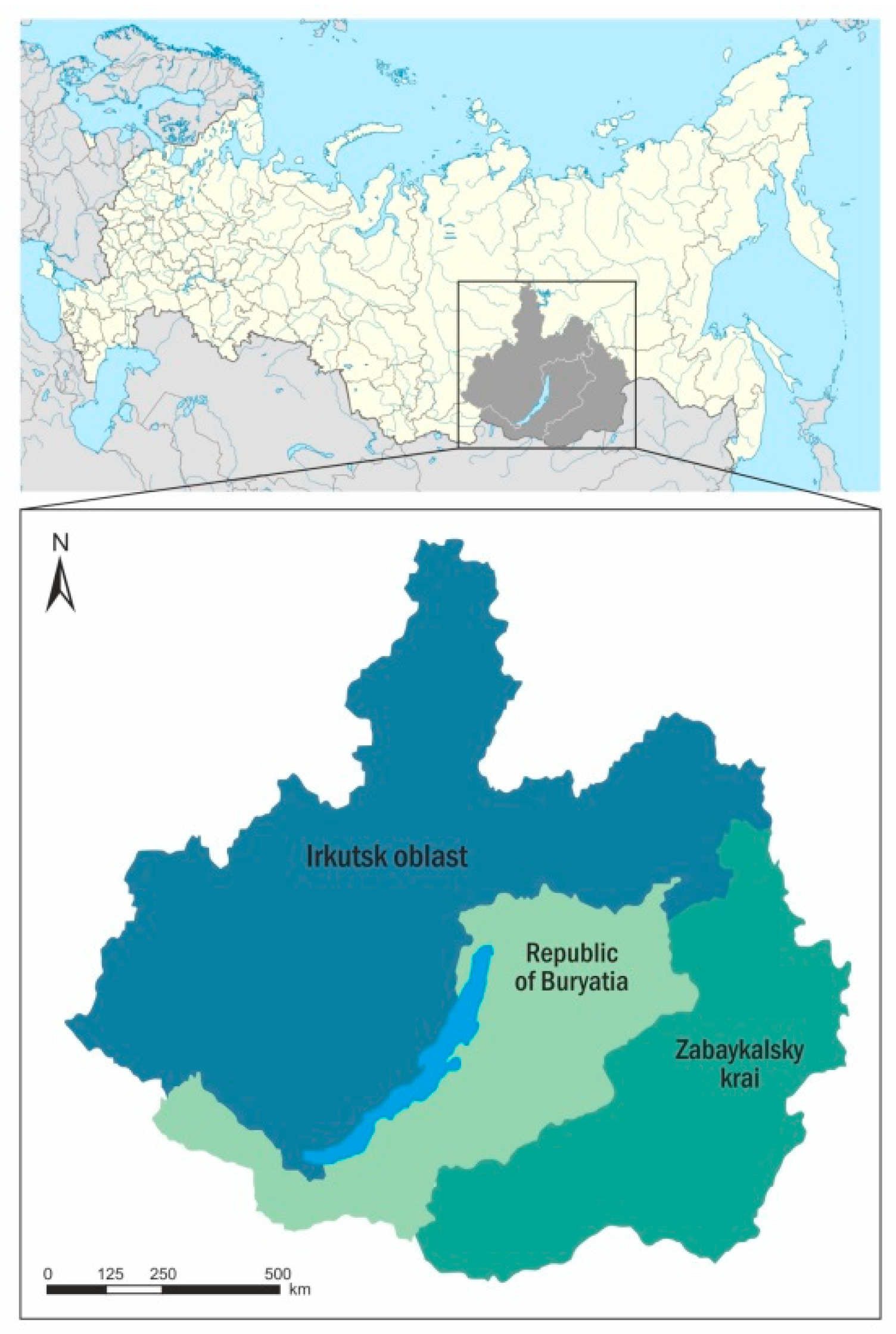
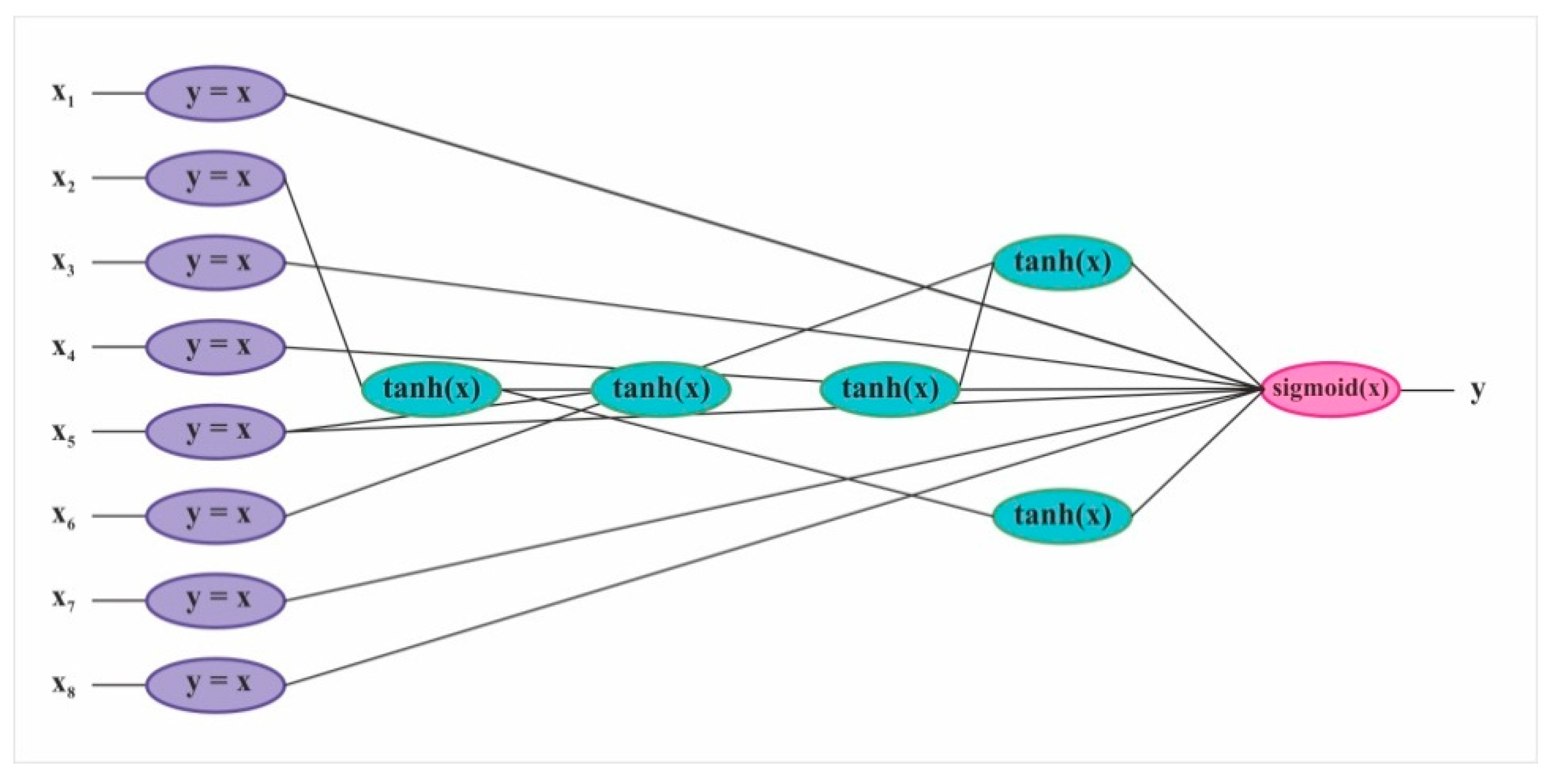
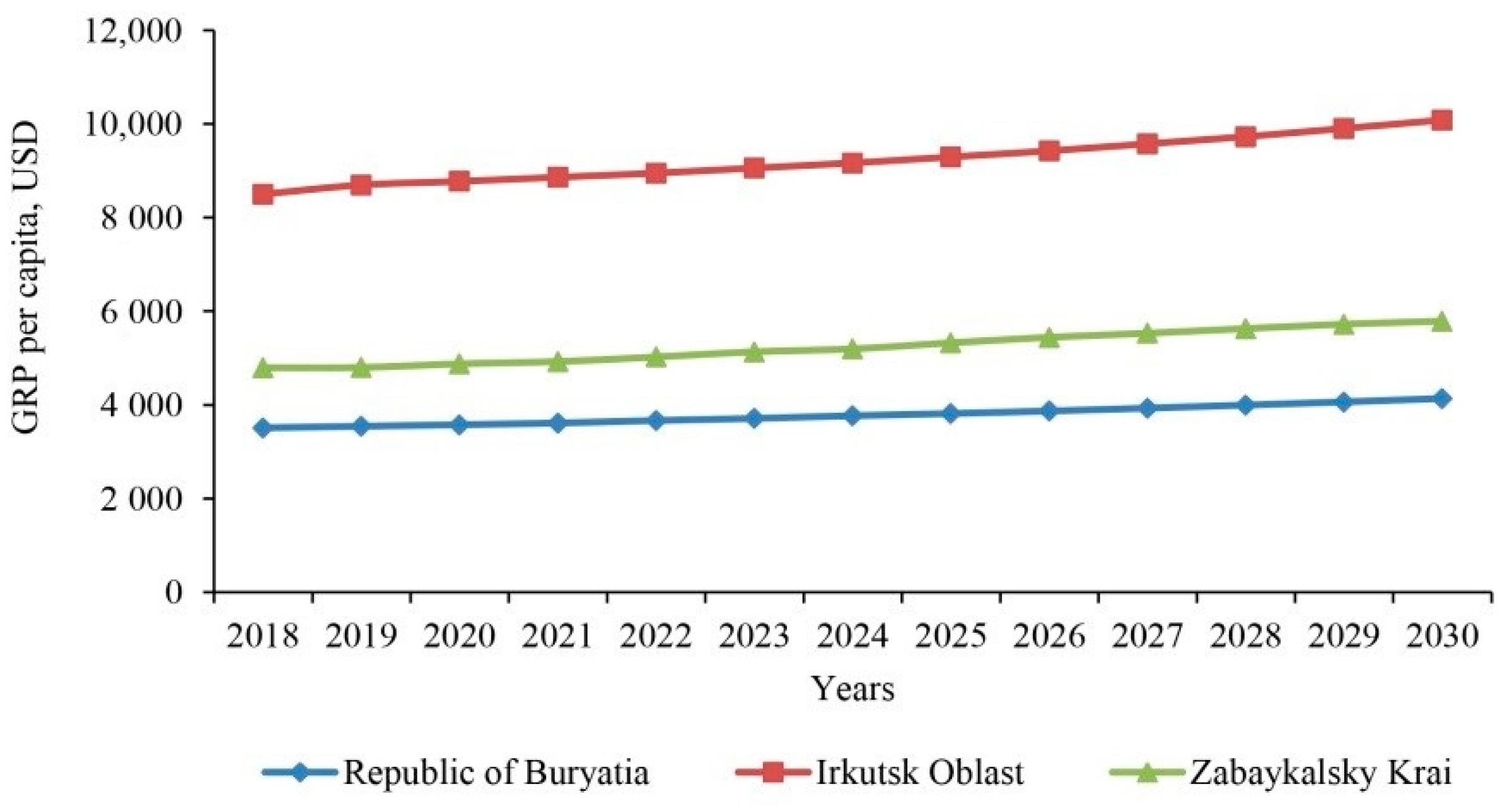
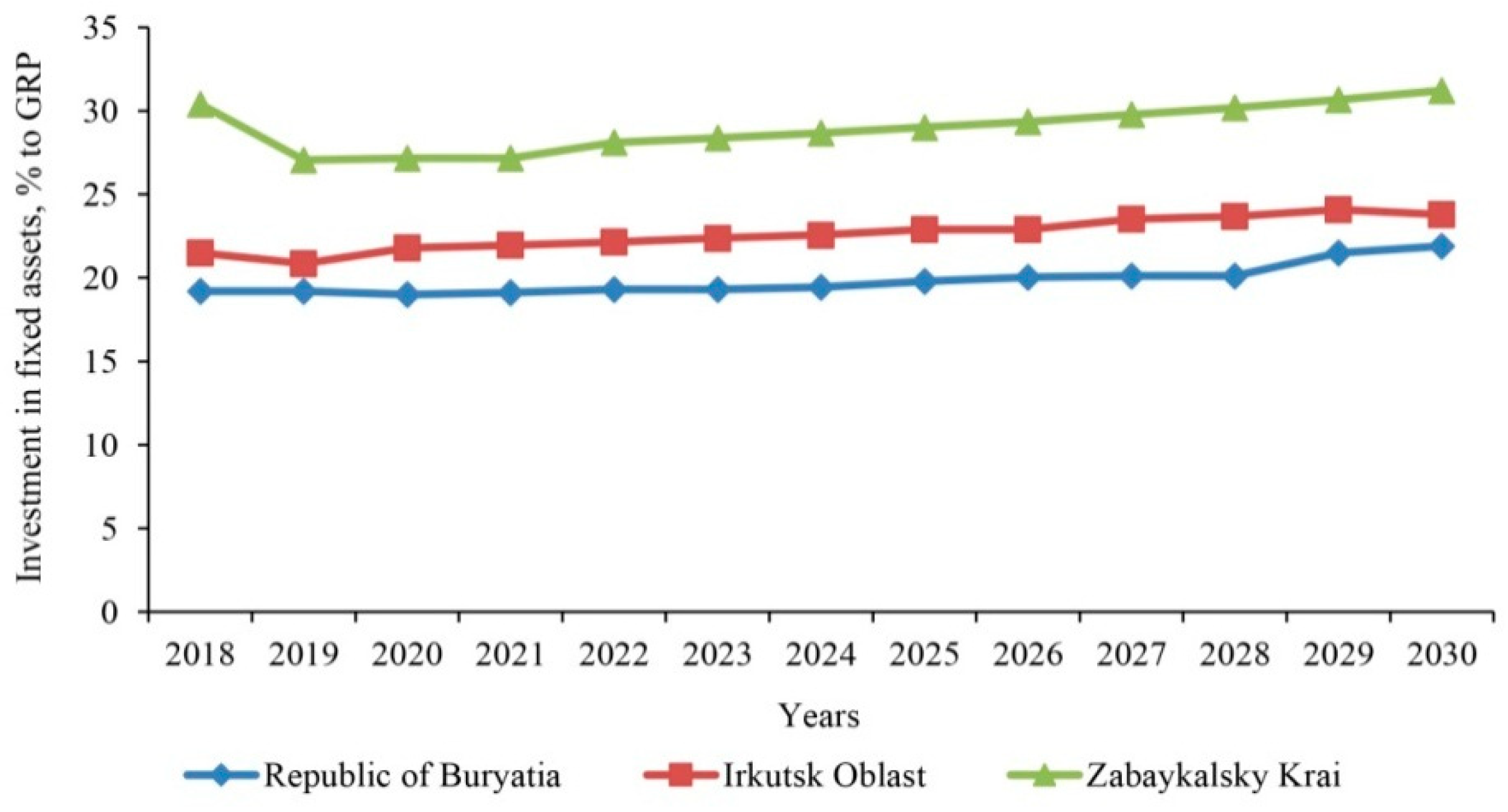
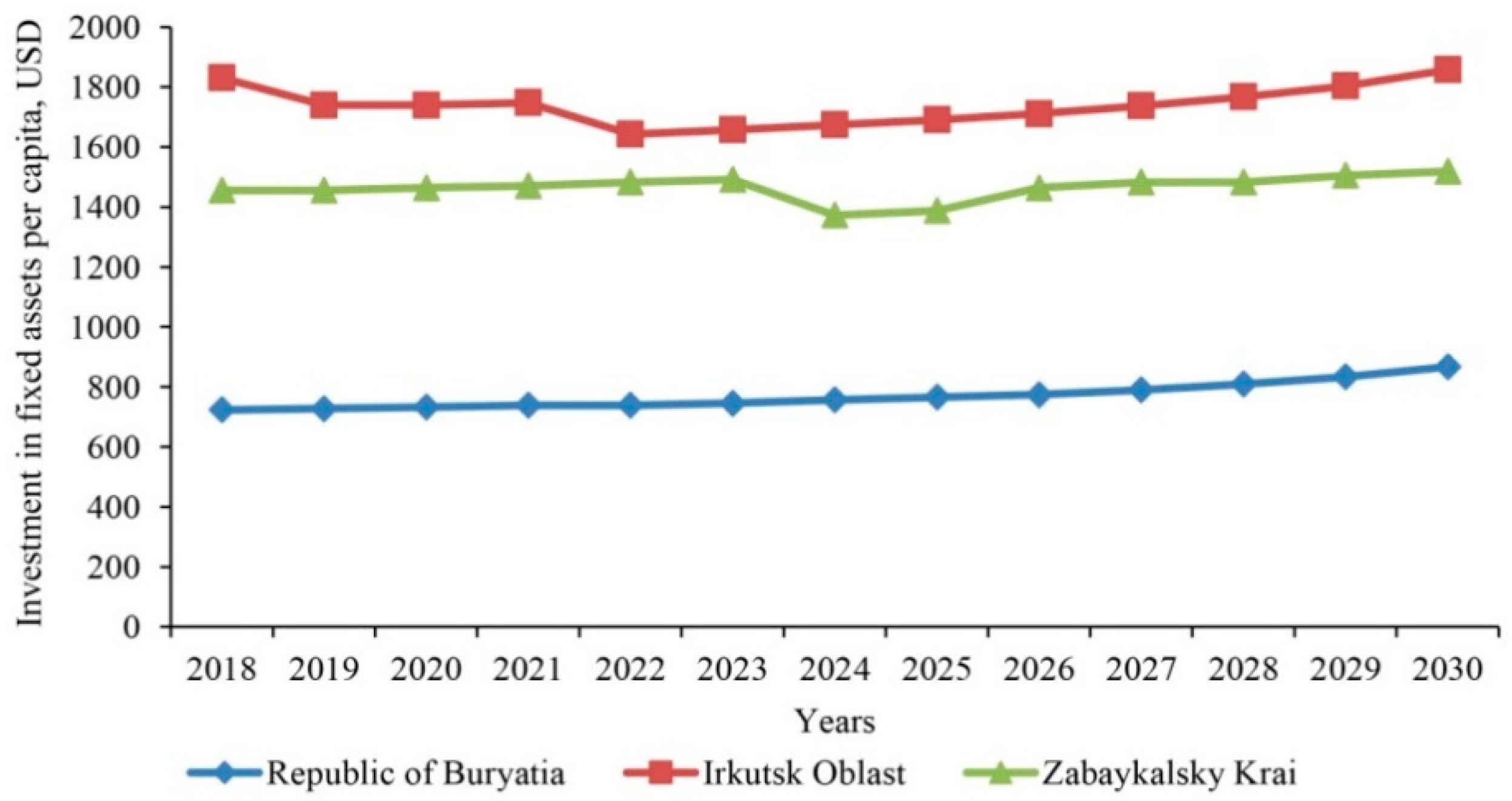
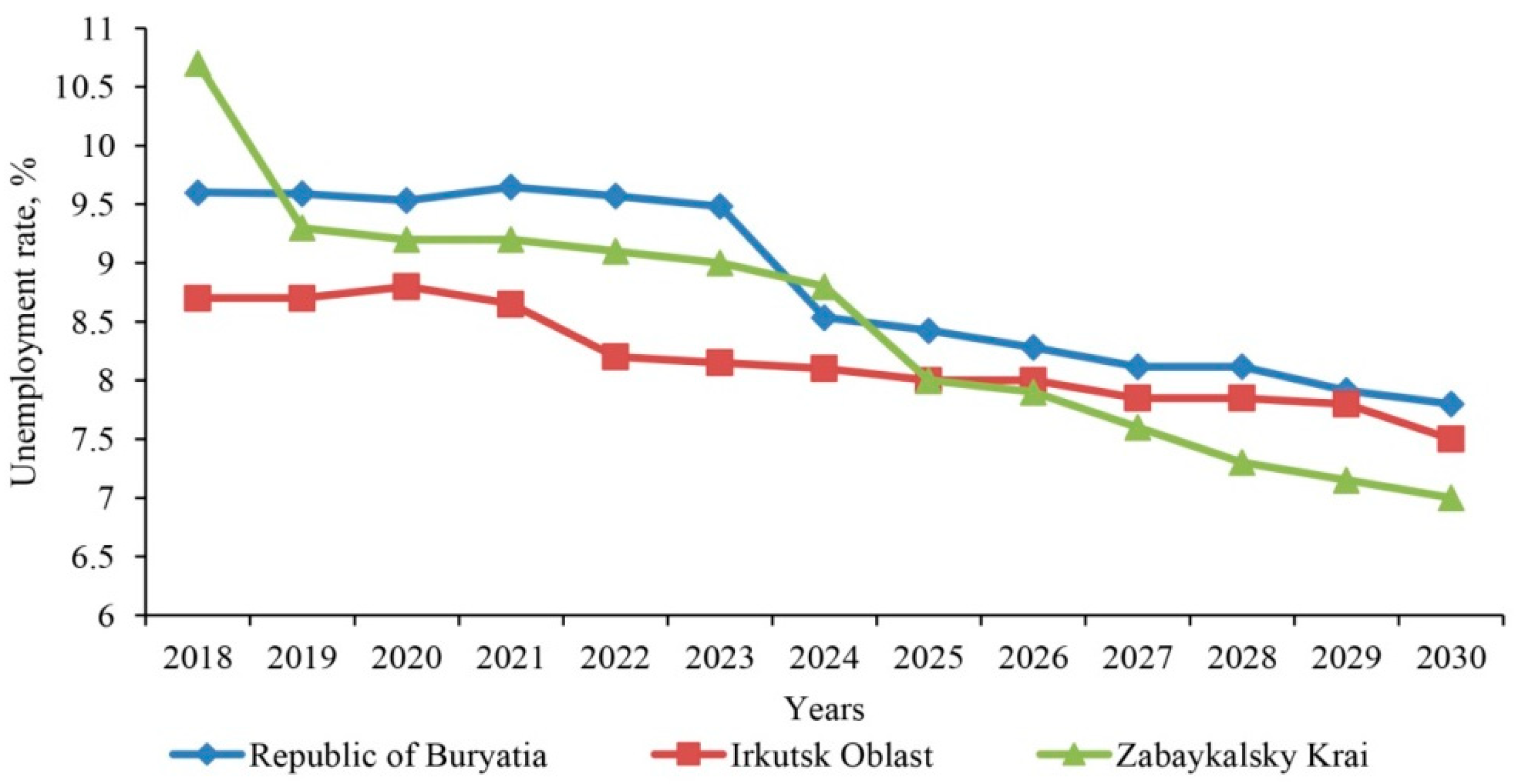
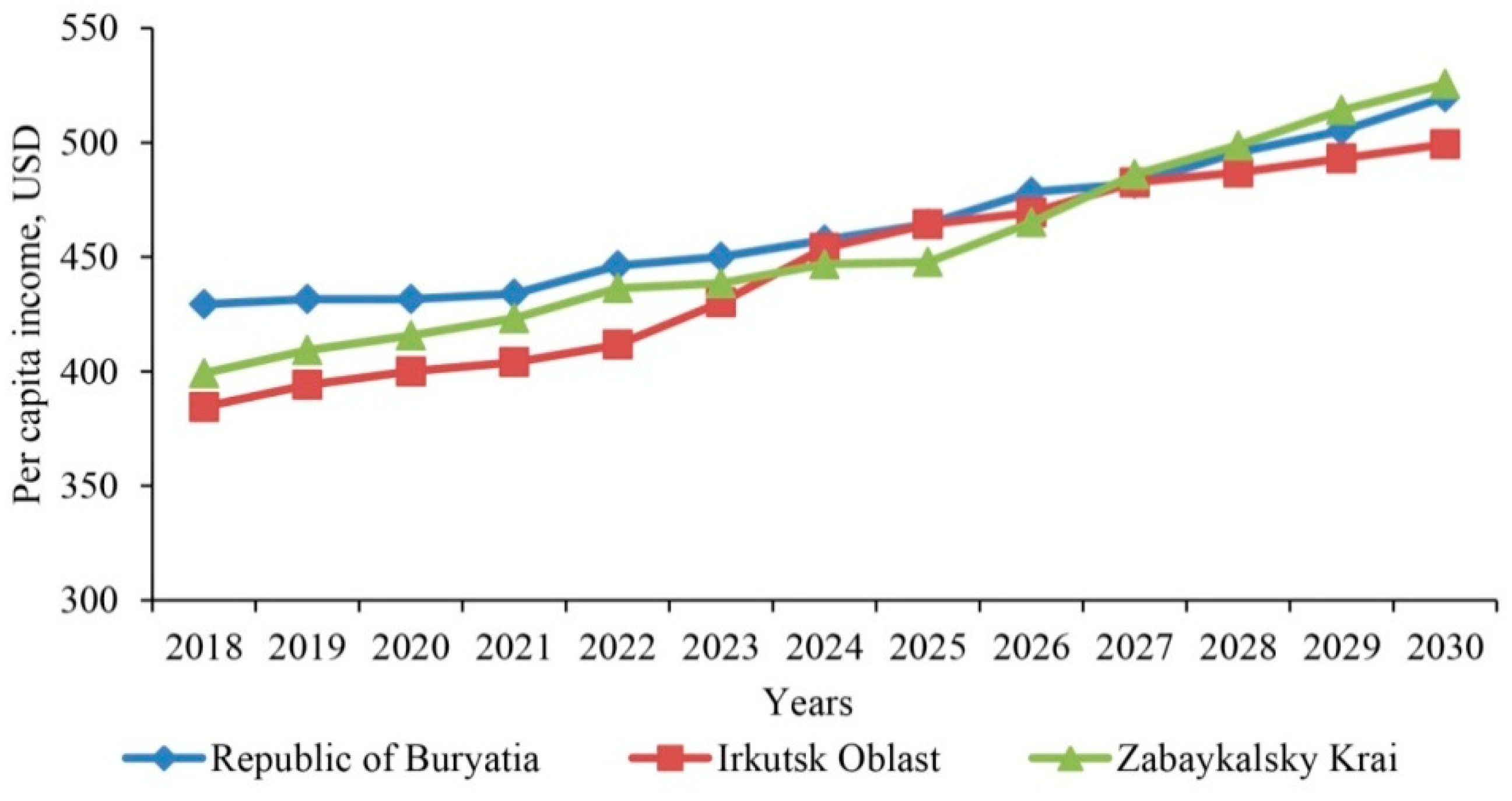
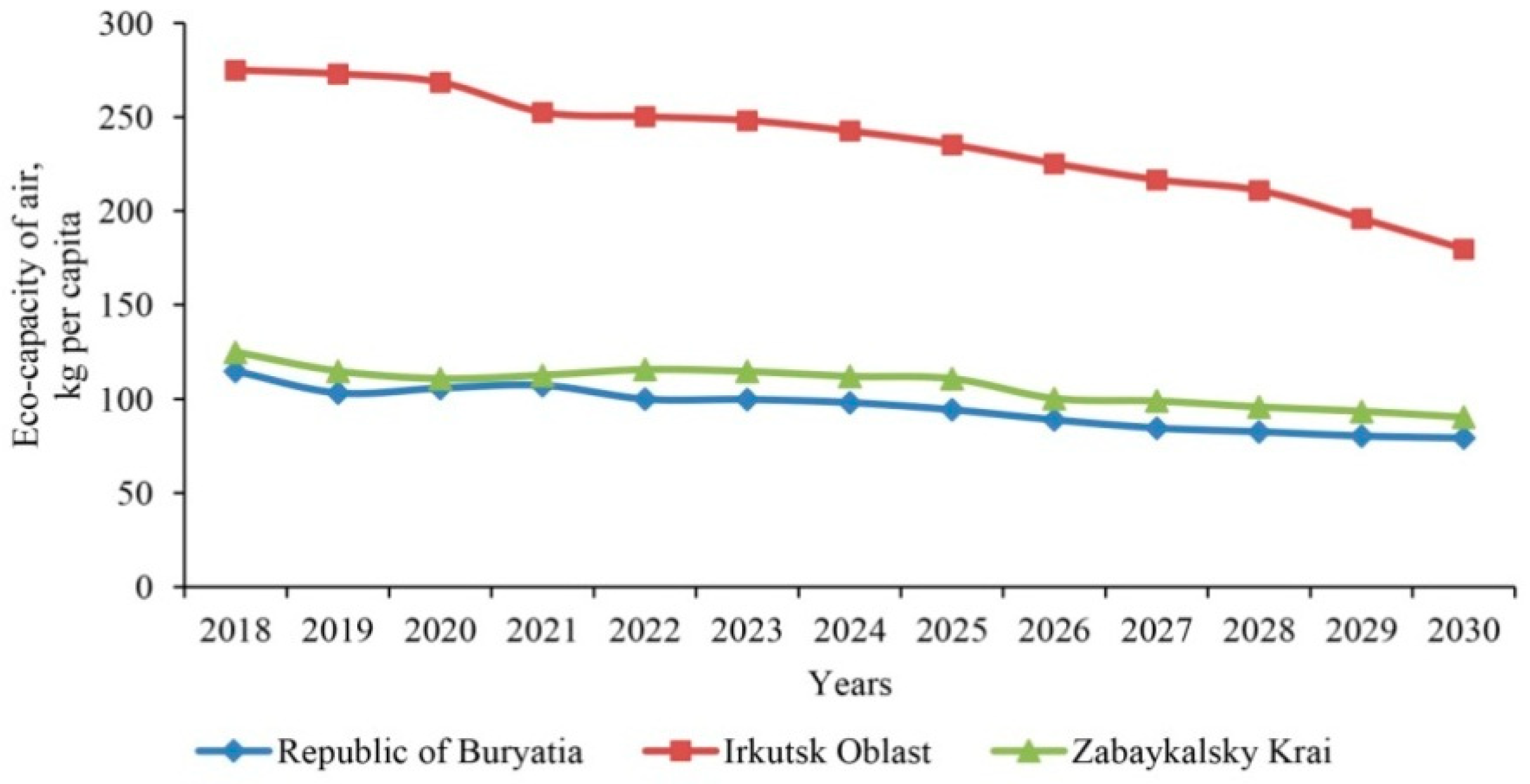
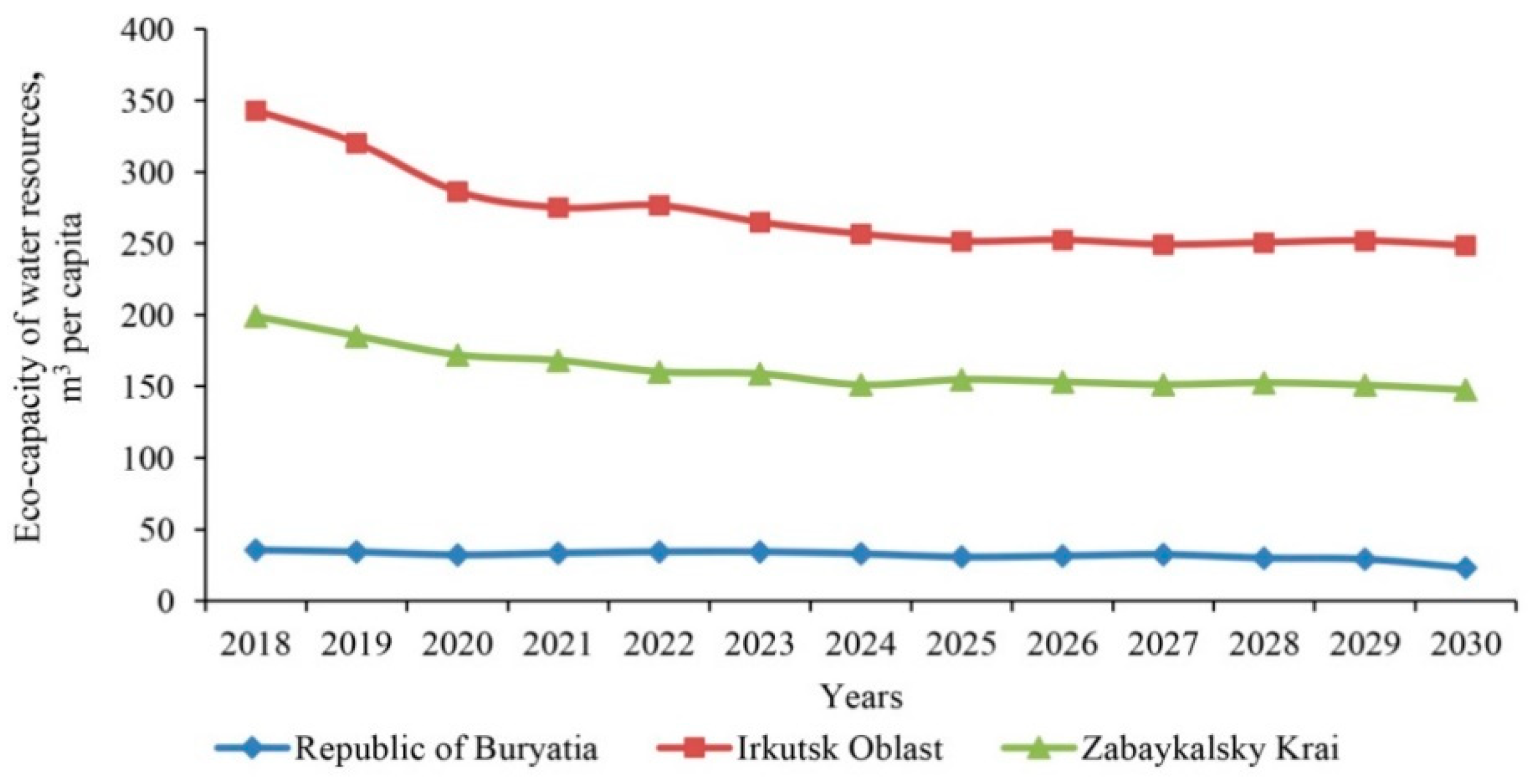
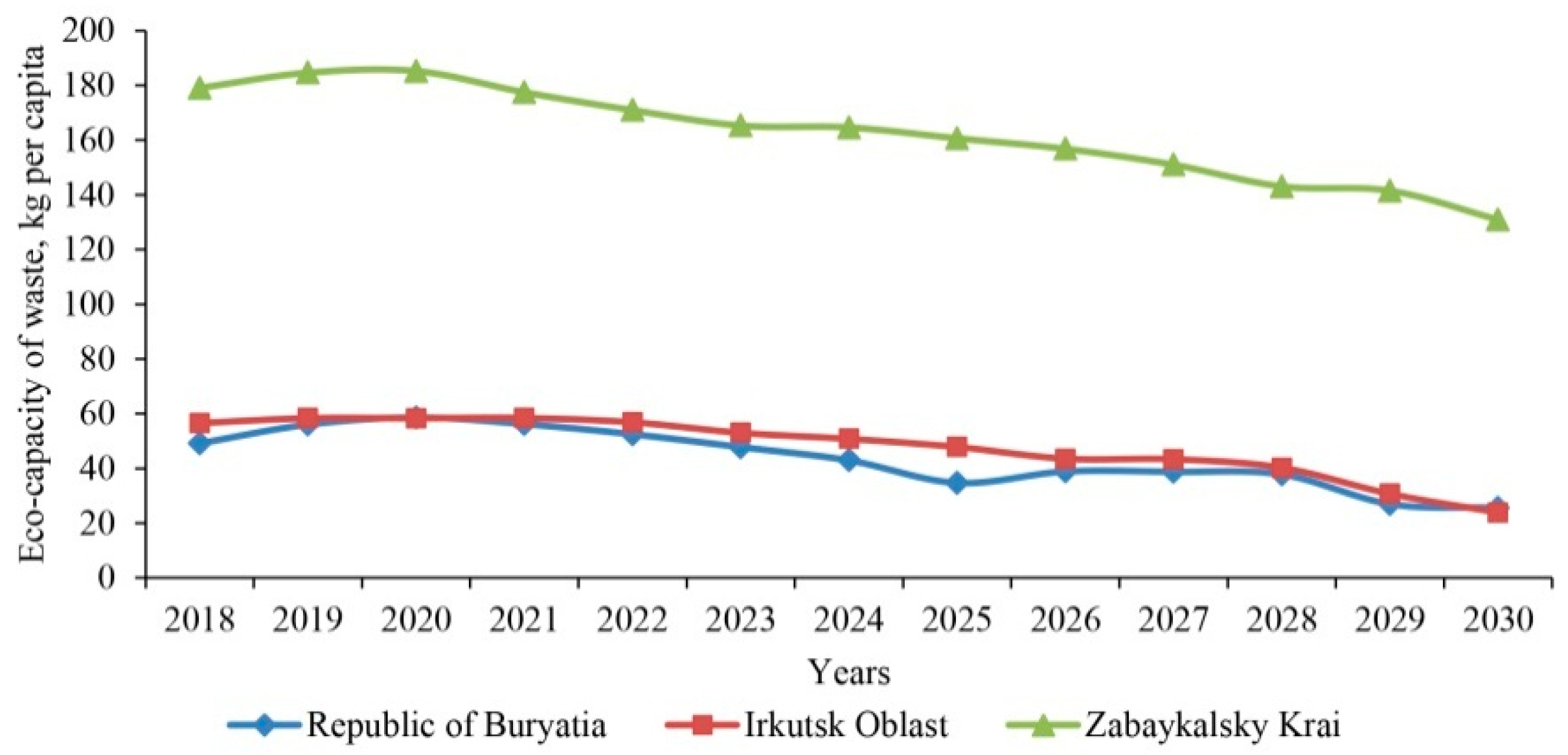
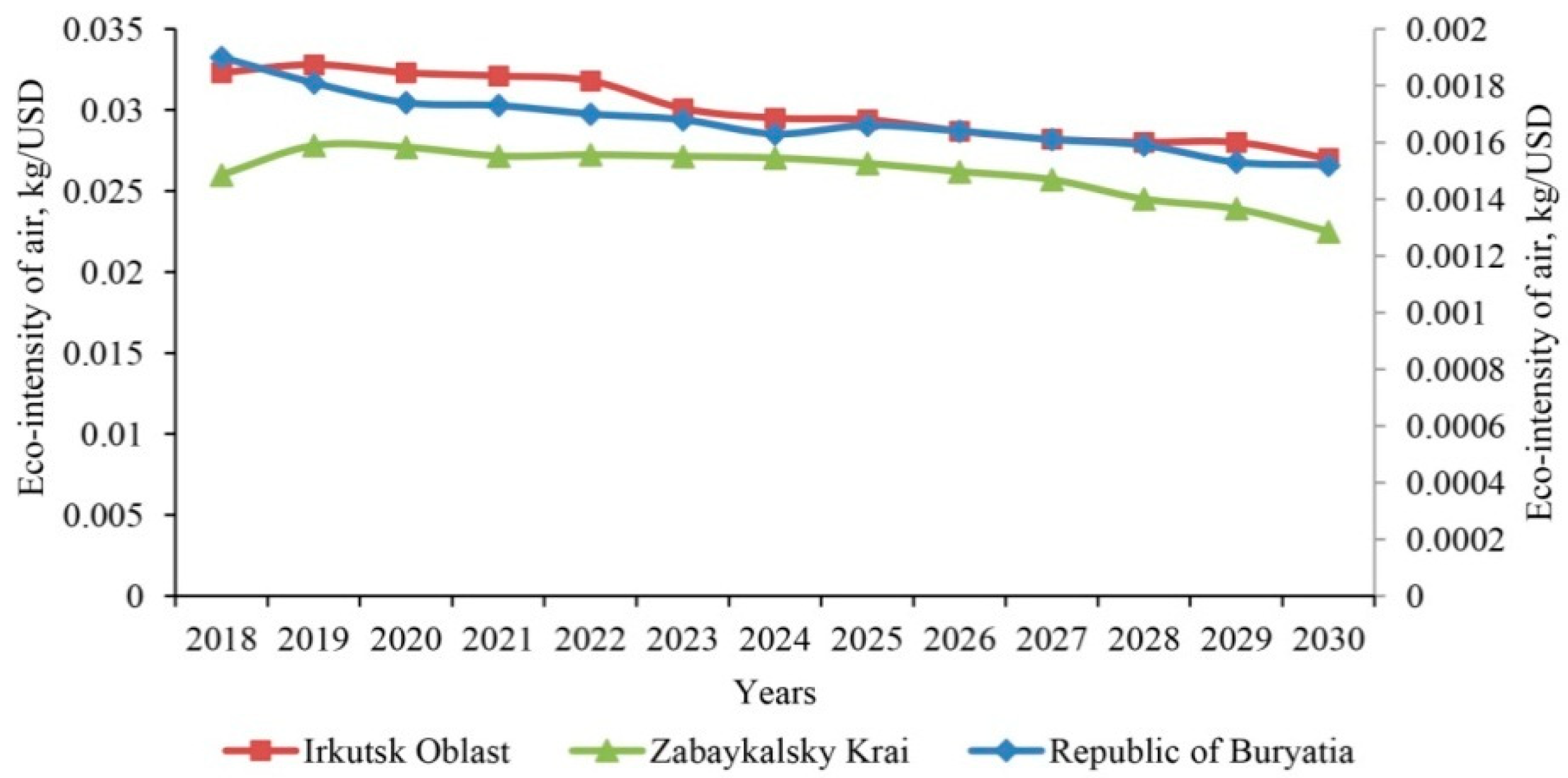
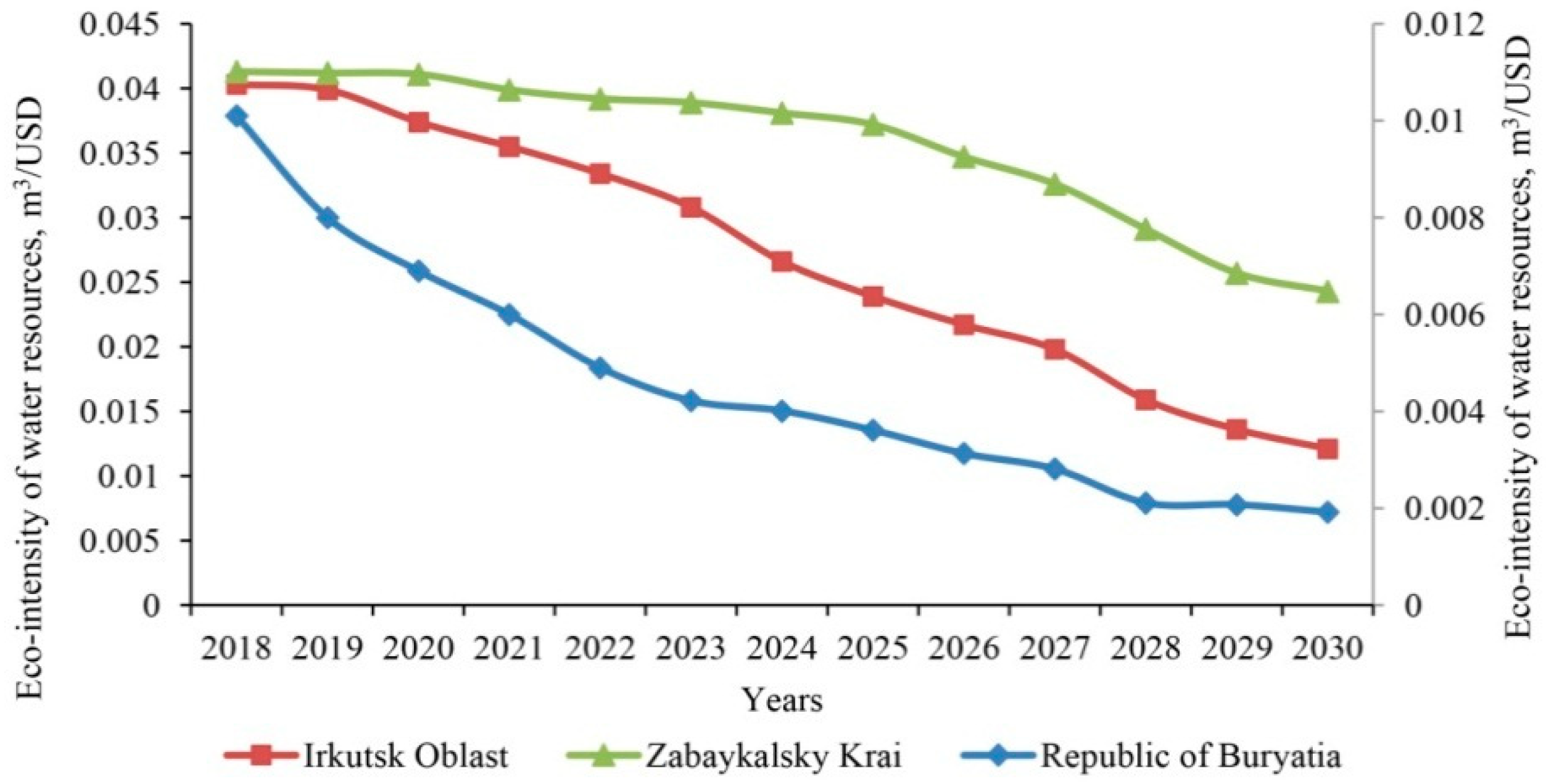
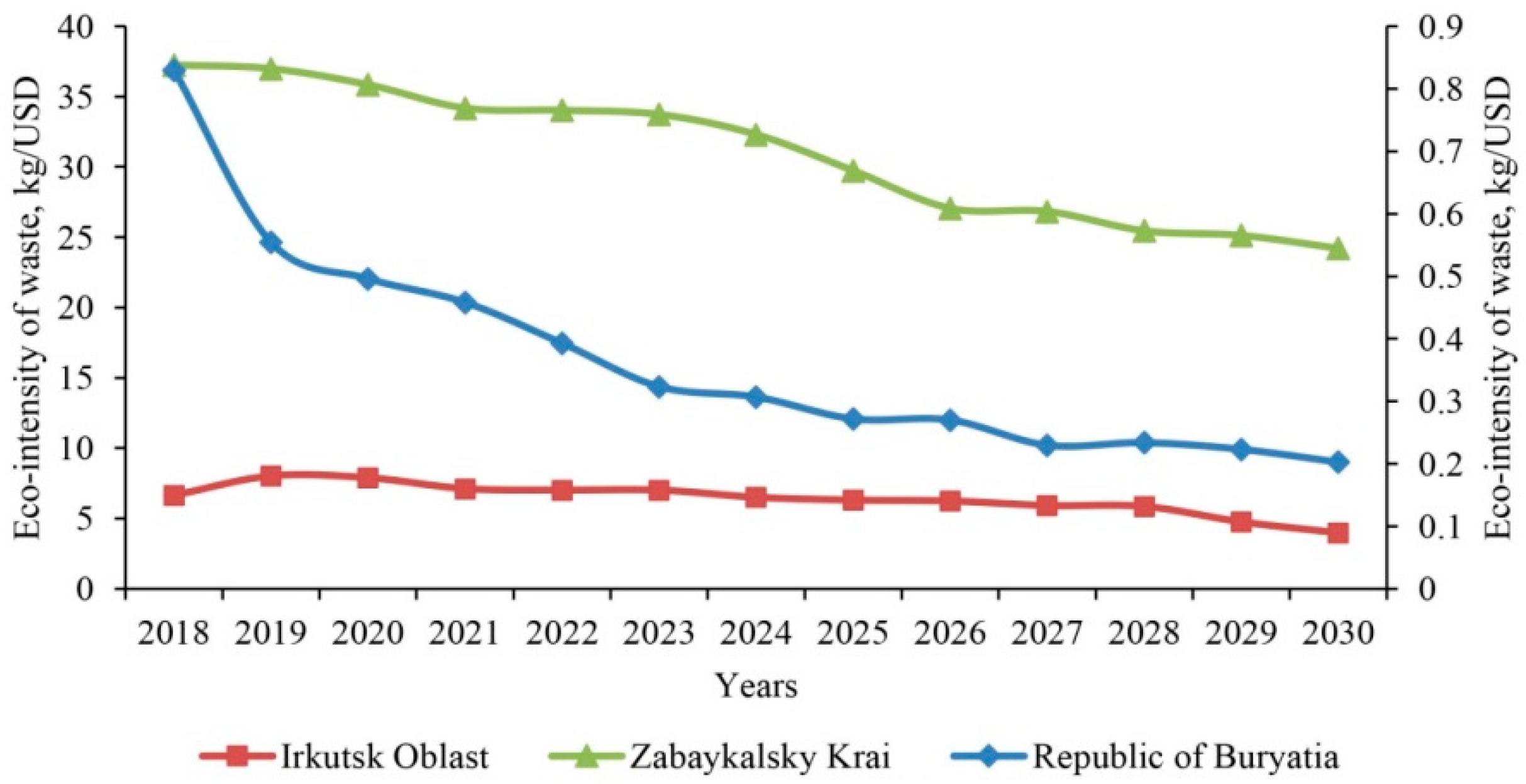
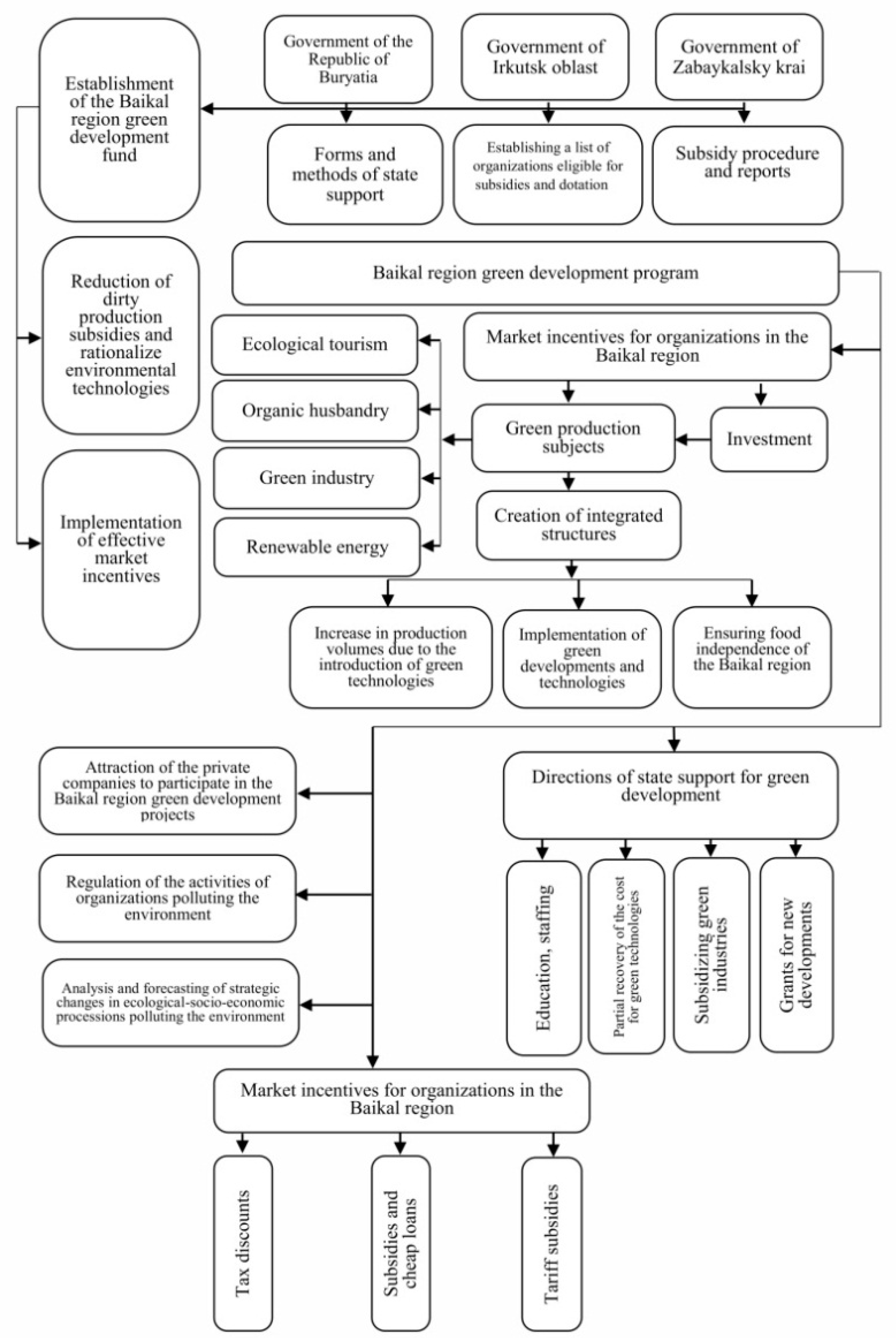
| No. | Indicator | Units | Factors | Units | |
|---|---|---|---|---|---|
| 1 | Eco-capacity of air (total amount of pollution per capita) | kg | 1 | GRP per capita | USD |
| 2 | Per capita income | USD | |||
| 2 | Eco-capacity of water resources (total amount of wastewater per capita) | m3 | 1 | Per capita industrial production | USD |
| 2 | Share of the population with incomes below the subsistence level | % | |||
| 3 | Eco-capacity of waste (total amount of waste per capita) | kg | 1 | Investments in fixed assets per capita | USD |
| 2 | Share of the employed population in the economy in the total population | % | |||
| 3 | Unemployment rate | % | |||
| 4 | Eco-intensity of air | tons/USD | 1 | Per capita income | USD |
| 2 | Per capita industrial production | USD | |||
| 3 | Unemployment rate | % | |||
| 5 | Eco-intensity of water resources | tons/USD | 1 | GRP per capita | USD |
| 2 | Per capita income | USD | |||
| 6 | Eco-intensity of waste | tons/USD | 1 | Investments in fixed assets per capita | USD |
| 2 | Share of the employed population in the economy in the total population | % | |||
| 3 | Unemployment rate | % | |||
| No. | Indicator | Units | Factors | Units |
|---|---|---|---|---|
| 1 | Eco-capacity of air (total amount of pollution per capita) | kg | GRP per capita | USD |
| Investments in fixed assets | % to GRP | |||
| Investments in fixed assets per capita | USD | |||
| 2 | Eco-capacity of water resources (total amount of wastewater per capita). | m3 | Per capita industrial production | USD |
| Share of the employed population in the economy in the total population | % | |||
| 3 | Eco-capacity of waste (total amount of waste per capita) | kg | Unemployment rate | % |
| Per capita income | USD | |||
| 4 | Eco-intensity of air | tons/USD | Industrial production indices | % to the previous year |
| 5 | Eco-intensity of water resources | tons/USD | ||
| 6 | Eco-intensity of waste | tons/USD |
Publisher’s Note: MDPI stays neutral with regard to jurisdictional claims in published maps and institutional affiliations. |
© 2020 by the authors. Licensee MDPI, Basel, Switzerland. This article is an open access article distributed under the terms and conditions of the Creative Commons Attribution (CC BY) license (http://creativecommons.org/licenses/by/4.0/).
Share and Cite
Bilgaev, A.; Dong, S.; Li, F.; Cheng, H.; Tulohonov, A.; Sadykova, E.; Mikheeva, A. Baikal Region (Russia) Development Prospects Based on the Green Economy Principles. Sustainability 2021, 13, 157. https://doi.org/10.3390/su13010157
Bilgaev A, Dong S, Li F, Cheng H, Tulohonov A, Sadykova E, Mikheeva A. Baikal Region (Russia) Development Prospects Based on the Green Economy Principles. Sustainability. 2021; 13(1):157. https://doi.org/10.3390/su13010157
Chicago/Turabian StyleBilgaev, Alexey, Suocheng Dong, Fujia Li, Hao Cheng, Arnold Tulohonov, Erzhena Sadykova, and Anna Mikheeva. 2021. "Baikal Region (Russia) Development Prospects Based on the Green Economy Principles" Sustainability 13, no. 1: 157. https://doi.org/10.3390/su13010157
APA StyleBilgaev, A., Dong, S., Li, F., Cheng, H., Tulohonov, A., Sadykova, E., & Mikheeva, A. (2021). Baikal Region (Russia) Development Prospects Based on the Green Economy Principles. Sustainability, 13(1), 157. https://doi.org/10.3390/su13010157







